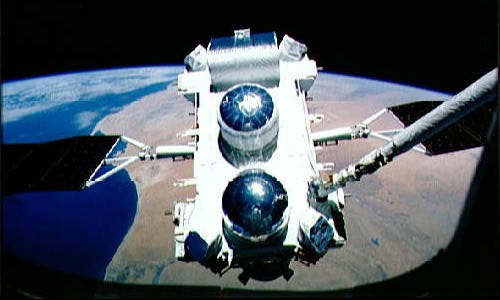BATSE on CGRO

The Compton Gamma-Ray Observatory (CGRO) was launched aboard the Space
Shuttle Atlantis on April 5, 1991 and was de-orbited in June
2000. Aboard were 4 instruments dedicated to the study of the
gamma-ray sky. The 9 years of continuous observations made by the
diferent instruments provide a wealth of information about the
Gamma-Ray sky.

The Burst and Transient Source Experiment (BATSE) aboard CGRO was an
all-sky monitor subject developed to detect and locate Gamma-ray
bursts and was sensitive in the energy range 20 keV-2 MeV. BATSE
consisted of 8 uncollimated NaI(Tl) Large Area Detectors (LADs),
located on each corner of the spacecraft; one of the modules is shown
in the image to the left. Also included in each detctor module was a
spectrometer, optimized to operate at 10 keV-100 MeV.
The Earth occultation method determines flux by measuring the step in the count rate profile in each BATSE detector as a source rises above or sets below the Earth's limb. Although BATSE had poor intrinsic angular resolution, the data can be used to survey the entire soft gamma-ray sky with <1o angular resolution and mCrab sensitivity by constructing images using the Earth occultation technique. To achieve this sensitivity the data set is flat-fielded by modelling the expected detector background in the LADs using the BATSE Mass Model (BAMM). The Likelihood Imaging Method for BATSE Occulatation data (LIMBO) code is a collection of computer programmes developed at Southampton to create all-sky maps from the BATSE data. Over twenty known sources have been imaged by BATSE. The nine year lightcurves of these sources provides invaluable information on the variabilty of these sources.
A full description of the Compton Gamma-Ray Observatory satellite and the BATSE instrument can be found on NASA's HEASARC and the National Space Science and Technology Center websites.